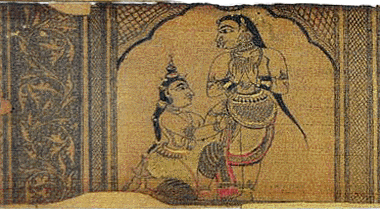Gita-govinda and Oriya Art Tradition
BY: NIMAI CHARAN MOHANTY

Orissan Palm-leaf Manuscript Page from Gita-Govinda
Nov 05, BHUBANESWAR, ORISSA (SUN) — Orissa is very rich in artistic and poetic traditions. Gita-govinda Kavya of Jayadeva is a superb literary creation. It was known to have been composed in the 12th century A.D. The songs were originally meant for recitation in the Jagannath Temple of Puri. There are seventy-two slokas, divided into 24 songs in 12 chapters. Since its creation, the work has become very popular all over India.
The controversy about the age and birthplace of Jayadeva has been extensively dealt with by many prominent scholars all over India. Most of them are of the opinion that Jayadeva was born in Orissa in the 12th century A.D. The village Kenduli on the Prachi valley in Khurda district has been identified as his birth place. One set of Ganga copper plate inscriptions has been found in this village. A small inscription, "Jaya Jagadisa Hare" on the lintel of the Devi temple is ascribable to 12th century A.D., further strengthening the historicity of Kenduli and its association with poet Jayadeva.
A large number of archaeological relics found in and around this village also speak of the antiquity of the site. Various religions such as Vaisnavism, Saivism, Saktism, Jainism, Buddhism, Dasavatara and Gopinath cults, etc., had great sway in the Prachi valley prior to 12th century A.D. The cultural revolution of the valley had a great influence on Jayadeva.
Due to the popularity of Gita-govinda, we find many commentaries and imitations since the days of its composition. There is a reference to Kenduvilva in ancient Hindi, Marathi, Bengali, Oriya and Maithili literature. In the Jagannath Temple of Puri, Gita-govinda-gana became a ritualistic tradition. The Dasavatara prayer of this work also had a great impact on the religious, social and artistic traditions of Orissa.
The palm leaf painting tradition of Orissa is replete with the Gita-govinda theme. A series of such paintings are now available in the Orissa State Museum. The linear, rhythmic compositions of Radha and Krishna, both in mono-chrome and bichrome, are some of the marvelous specimens. Since antiquity, Orissa has been famous for her paintings, including the prehistoric paintings, engravings and line drawings found at Vikram Khol and Ulapgarh in Jharsuguda district. Manikmunda and Usakothi in Sundergarh District, Gudahandi and Jogimath in Kalahandi district, together with the Sitabinji historical paintings of Keonjhar district are the mines of our heritage.
The accumulated art tradition reached its pinnacle in palm leaf paintings of Orissa. Flora, fauna and human figures have been flamboyantly executed with precision and sharpness. Palm leaf manuscripts are generally called pothis. The manuscripts that are illustrated are called chitrapothis. Such later chitrapothis contain text as well as paintings. A series of manuscripts are also known to have been painted, but by far, the Gita-govinda pothis excel all other texts in lively illumination and these themes have been copiously consigned to all media of the Orissan Art idiom.
The sculptural representation of Dasavatara themes are found in the early temples of western Orissa and Chhatisgarh region. Mahasivagupta Balarjuna (750-807 AD) built the famous Laxmanswar Temple at Sirpur. On the lintel of this temple, Dasavatara figures are carved. At Saintala, we find representation of Dasavatara in two Vishnu images.

At Gandharadi in Boudh district, Bhanja King Satrubhanja had built Siddheswara and Nilamadhava temples on one platform. We find some Dasavatara figures in the Nila Madhav temple. Interestingly, even in the Vaital Temple of Bhubaneswar, a few Dasavatara figures have been carved out. Prachi valley is teeming with ancient Saiva and Madhava temples. In most of the later temples, we find Dasavatara panels. The cult of Dasavatara and its sculptural representations in Orissa prior to Jayadeva had significantly influenced the concept of avatara depicted in Gita-govinda.
This work has also inspired new musical compositions in Kerala and Tamilnadu. From Gujrat to Assam and from Kerala to Kasmir, it has inspired a series of commentaries. Painters have taken great inspiration from the work, and we find specimens of paintings in Assam, Rajasthan, Himachal Pradesh and Gujrat. Its theatrical diction was also known to have been spread into Nepal and Manipur.
Nimai Charan Mohanty is the Curator (Art and Craft) of Orissa State Museum, Bhubaneswar.
Source: 'Orissan Review'.
